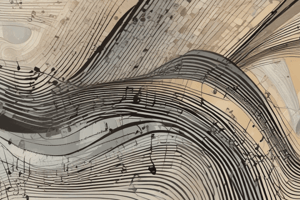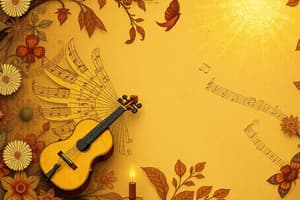Podcast
Questions and Answers
How does ternary form differ from binary form in music?
How does ternary form differ from binary form in music?
- Ternary form involves a recurring theme between contrasting episodes, unlike binary form.
- Ternary form directs the music reader to repeat sections, a feature absent in binary form.
- Ternary form consists of one part repeated throughout, while binary form has two parts.
- Ternary form has three parts, with the third being a repeat or modified version of the first, while binary form has two parts with different sound and feel. (correct)
In musical notation, what is the primary function of the 'Segno' symbol?
In musical notation, what is the primary function of the 'Segno' symbol?
- To indicate a jump to the coda section.
- To indicate the end of a musical piece.
- To mark a section for repetition, similar to the start-repeat sign. (correct)
- To direct a return to the beginning of the piece.
If a musical piece includes 'DAL SEGNO al Coda', what should the performer do?
If a musical piece includes 'DAL SEGNO al Coda', what should the performer do?
- Skip directly to the section marked 'Coda'.
- Return to the measure where the 'Segno' is placed, play until the 'Coda' symbol, then jump to the coda section. (correct)
- Repeat from the beginning of the piece and end at the 'Fine' marking.
- Repeat from the beginning of the piece until the 'Coda' symbol, then jump to the coda section.
Which musical direction indicates a return to the very beginning of a piece?
Which musical direction indicates a return to the very beginning of a piece?
In the context of silkscreen printing, what is the purpose of the 'positive space'?
In the context of silkscreen printing, what is the purpose of the 'positive space'?
Which of the following sequences accurately describes the initial steps in silkscreen printing on a t-shirt?
Which of the following sequences accurately describes the initial steps in silkscreen printing on a t-shirt?
What is the defining characteristic of folk dance, distinguishing it from other dance forms?
What is the defining characteristic of folk dance, distinguishing it from other dance forms?
Which of the following is a common symptom explicitly associated with the common cold?
Which of the following is a common symptom explicitly associated with the common cold?
Which respiratory disease is specifically caused by the bacterium Corynebacterium diphtheriae and characterized by a thick gray-white coating in the throat?
Which respiratory disease is specifically caused by the bacterium Corynebacterium diphtheriae and characterized by a thick gray-white coating in the throat?
What is the primary cause of rhinitis, distinguishing it from other respiratory infections?
What is the primary cause of rhinitis, distinguishing it from other respiratory infections?
Flashcards
Form (Music)
Form (Music)
The organization of music, showing how musical elements of a composition are put together.
Binary Form
Binary Form
A musical form consisting of two parts with differences in sound and feel.
Ternary Form
Ternary Form
A musical form with three parts, the third being a repeat or modification of the first.
Strophic Form
Strophic Form
Signup and view all the flashcards
Repeat Marks
Repeat Marks
Signup and view all the flashcards
Start Repeat Sign
Start Repeat Sign
Signup and view all the flashcards
End Repeat Sign
End Repeat Sign
Signup and view all the flashcards
To CODA
To CODA
Signup and view all the flashcards
Fine
Fine
Signup and view all the flashcards
Da Capo
Da Capo
Signup and view all the flashcards
Study Notes
- Form is the organization in music that shows how musical elements of a composition are put together
Musical Forms
- Binary form consists of two parts of music with differences in sound and feel
- Ternary form has three parts, with the third being a repeat or a modified version of the first
- Strophic form contains only one part that is repeated throughout the music, and it is considered a basic form
- Rondo form has a recurring theme in between contrasting parts called episodes
Musical Marks and Symbols
- Repeat marks guide the music reader to where to return in the piece
- Start Repeat Sign indicates where the music repeats
- End repeat sign directs a return to the start repeat sign or the beginning of the piece if there is no start repeat sign
- Endings indicate a different ending after the repeat
- Segno marks a section to be repeated and literally means "sign"
- CODA indicates the section the music jumps to, means "tail," and serves as a closing section
- To CODA indicates the part to be skipped when jumping to the CODA section
- Fine indicates the measure where the music ends after a repeat
- Da capo directs a return to the start of the piece and means "head"
- DAL SEGNO directs a return to the measure where a segno is placed
- Da Capa al fine directs repeats from the beginning until the measure where a fine is placed
- DAL SEGNO al Coda means the music repeats the section specified by the SEGNO then jumps to the Coda part
- DAL SEGNO AL FINE means the music repeats the section specified by the segno until the measure where a fine is placed
Printmaking and Silkscreen
- Printmaking is an art process that transfers design patterns to a surface
- Serigraphy or silkscreen printing cuts a design out from a screen for printing
- Silkscreen printing steps:
- Type and print a design on Oslo paper
- Cut out the design parts with a cutter, separating positive and negative spaces
- Prepare the frame with a t-shirt and cardboard
- Place the shirt on a surface, insert cardboard, set the Oslo paper, and place the silkscreen
- Gently pour textile paint on the silkscreen
- Hold and fix the silkscreen, apply paint gradually
- Lift the screen, let the paint dry, and clean the screen
Folk Dance
- Folk dance is a traditional dance that forms part of a culture or tradition
- Basic hand positions include:
- Closed hand
- Arms oblateral
- Upright/Side-Left
- Up-right Close/Left
- Up-right/Left
- Basic feet positions include:
- Waltz
- Galop
- Chain Step
- Polka
Respiratory Diseases
- Respiratory diseases affect organs of the respiratory system, such as the nose, throat, voice box, windpipe, bronchi, and lungs
- Sore throat refers to throat pain, itchiness, or irritation, caused by bacterial infection like streptococcal bacteria
- Diphtheria is a deadly infectious disease from Corynebacterium diphtheriae, forming a thick gray-white coating in the throat
- Common cold is a viral infection of the nose and throat, with symptoms like sneezing and excessive nasal secretion
- Influenza or flu is a respiratory system infection caused by airborne viruses
- Whooping cough or pertussis is a bacterial infection that causes loss of cilia in the trachea
- Tuberculosis is a bacterial disease usually affecting the lungs, caused by Mycobacterium tuberculosis, forming lesions
- Pneumonia is a bacterial or viral infection causing inflammation of the alveoli
- Asthma is a chronic disease that inflames and narrows the airways
- Bronchitis is inflammation of the bronchial tube
- Rhinitis is inflammation of the nasal lining caused by allergens like pollen, dust, mold, or animal skin flakes
Studying That Suits You
Use AI to generate personalized quizzes and flashcards to suit your learning preferences.



